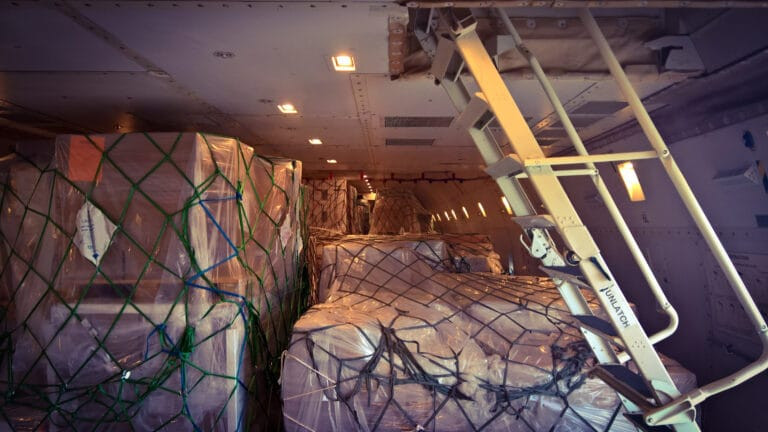- The removal of the US de minimis exemption from August 2025 means over a billion low-value shipments annually will require formal customs clearance, prompting air cargo operators, integrators, and shippers to adopt measured, collaborative strategies to avoid operational disruption while differentiating mission-critical goods from standard parcels
- Anticipated impacts include potential modal shifts from air to ocean freight, inventory stockpiling by exporters and importers, pressure on air cargo spot rates, and adoption of tiered pricing strategies to prioritise revenue quality and predictability over pure volume
- Network and operational adaptations are underway, including reconfiguring ground handling at major US gateways, exploring nearshore distribution in Central America and Mexico, utilising bonded and Foreign Trade Zones, and implementing tiered service levels to manage longer dwell times and higher processing volumes efficiently
From late August 2025, the elimination of the de minimis exemption — a rule that has allowed millions of low-value parcels to bypass formal customs clearance — will come into force. For an industry that has long relied on the rapid movement of lightweight e-commerce shipments from Asia to the United States, the implications are vast.
The question now is how quickly airlines, integrators, shippers and regulators can adjust to a reality in which more than a billion additional shipments must pass through formal customs processing every year.
The removal of the exemption could send a wave of disruption across the Pacific, where flows of consumer goods underpin much of the trade. Stephen Dyke, Principal Solutions Consultant Manager at FourKites, described the challenge as “a delicate balancing act” that will demand both speed and restraint.
“If operators take two to six weeks to restructure their strategies to counter the de minimis exemption, only to have policies revert, they risk significant operational disruption and wasted investment,” Dyke explained. “This uncertainty is driving a measured, collaborative approach rather than panic-driven changes.”
The scale is unprecedented. According to the White House, US Customs and Border Protection processed more than 1.36 billion de minimis shipments in the last financial year. From 29 August 2025, all of them will require formal entry filings. “Collaboration is key and actively underway between air cargo operators and their customers, working as partners to navigate these changes together,” Dyke noted.
In practice, this collaboration means differentiating between mission-critical cargo and lower-value items. “Non-critical inventory and lost revenue goods are being adapted to broader bulk air cargo strategies,” Dyke said. “Mission-critical goods laser focus on customs clearance efficiencies with associated duty costs absorbed into broader financial strategies.”
The emphasis is on avoiding what he calls a “tidal wave” effect on operations. Instead of reacting bluntly, companies are taking a more surgical approach: evaluating strategies, exploring alternatives, and adapting procedures gradually. Yet the real stress test will come when enforcement begins in earnest, particularly at high-volume gateways such as Los Angeles, Miami and New York.
Modal shifts and pricing power
One of the biggest questions is whether this policy change could accelerate a shift from air to ocean transport for e-commerce. Dyke believes the risk is real but not straightforward. “The key factors determining this modal shift are ensuring supply availability, managing transit lead times, and implementing proper inventory management to support the transition,” he said.
Chinese exporters and US importers have already begun stockpiling inventories via ocean freight in anticipation of tighter rules. The calculus comes down to whether the cost of carrying additional inventory outweighs the duty costs of moving goods by air. “These changes are forcing companies to perform detailed analysis on current state operations, costs, and supply/demand processing so financial impacts can justify changes in logistics strategy,” Dyke explained.
For airlines, the immediate effect could be pressure on spot rates, which some analysts warn may fall below US$3 per kg on certain lanes. Carriers are adjusting by experimenting with tiered pricing structures. “The primary strategy is offering the market lock-in periods that can navigate the fluidity of global trade,” Dyke said. “Airlines are responding with tiered pricing strategies: offering longer-term stability at premium rates for risk-averse shippers, while maintaining spot capacity for those willing to accept volatility.”
The result is a shift away from pure volume towards what Dyke terms “revenue quality and predictability”. In other words, the value lies not in how much freight is moved, but in how well its movement can be forecast and monetised.
Yet volatility remains the defining feature. “Long-term implications will be validated and stabilised only as global trade policies settle and companies complete their detailed analysis,” Dyke stressed. “Currently, air cargo providers are under pressure to raise rates while forecasting volume declines and possibly altering route schedules. Expect continued volatility until new equilibrium points emerge based on actual operational data rather than projections.”
Adapting networks and fulfilment models
If the trans-Pacific trade is to weather the storm, much will depend on how quickly networks adapt. Customs brokers have called this the “largest paperwork shock in a decade”, with new requirements for 10 digit HTS codes and the end of Entry Type 86 for low-value imports from China and Hong Kong. Previous pilot attempts led to severe backlogs at JFK, underscoring the risks.
“Terminal operators at major gateways face unprecedented processing volumes,” Dyke said. “The infrastructure hardening continues, but questions remain about adequate staffing and system capacity to handle the surge.” Longer dwell times at express hubs could become the norm, forcing operators to introduce tiered service levels that prioritise mission-critical goods while leaving standard e-commerce to wait.
Ground handling is also shifting. Dyke pointed to the “pressure test” already building at airports such as LAX and MIA. “Ground handlers must reconfigure from high-frequency small parcel processing to lower-frequency, higher-volume consolidated shipments, requiring different equipment, labour allocation and scheduling patterns,” he said.
The search for resilience is extending beyond the US. Some companies are examining nearshore options in Central America or Mexico, where distribution centres could absorb inventory before final movement into the US. “The opportunity isn’t in compliance avoidance but in strategic positioning,” Dyke explained. “Using nearshore facilities for value-add operations, final assembly or inventory staging optimises the total landed cost equation while maintaining service levels.”
At the same time, renewed interest in bonded zones and Foreign Trade Zones reflects the scramble for financial levers to offset rising compliance costs. “The interest is selective rather than universal,” Dyke noted. “The key determinant is whether operational sophistication and volume justify the investment in FTZ infrastructure and compliance systems.”
Ultimately, he believes the structural foundations of airfreight will remain intact. “I don’t believe it will permanently change the fundamental structure,” he said. “The anticipated shift from 90 percent air freight to a 60–40 percent blend of direct fulfilment and forward stock represents evolution rather than revolution. The winners will be those who best balance service, cost and inventory investment based on true customer willingness to pay.”





